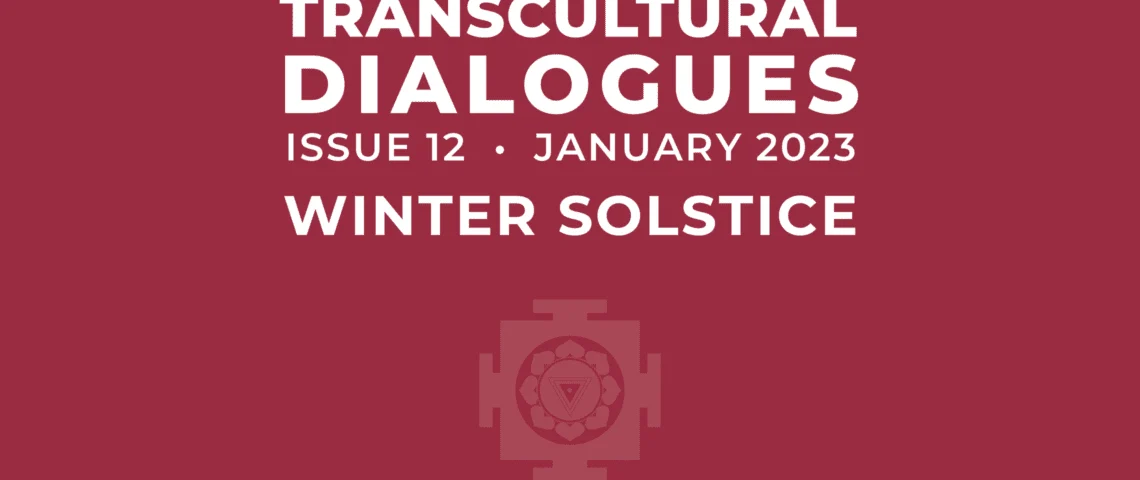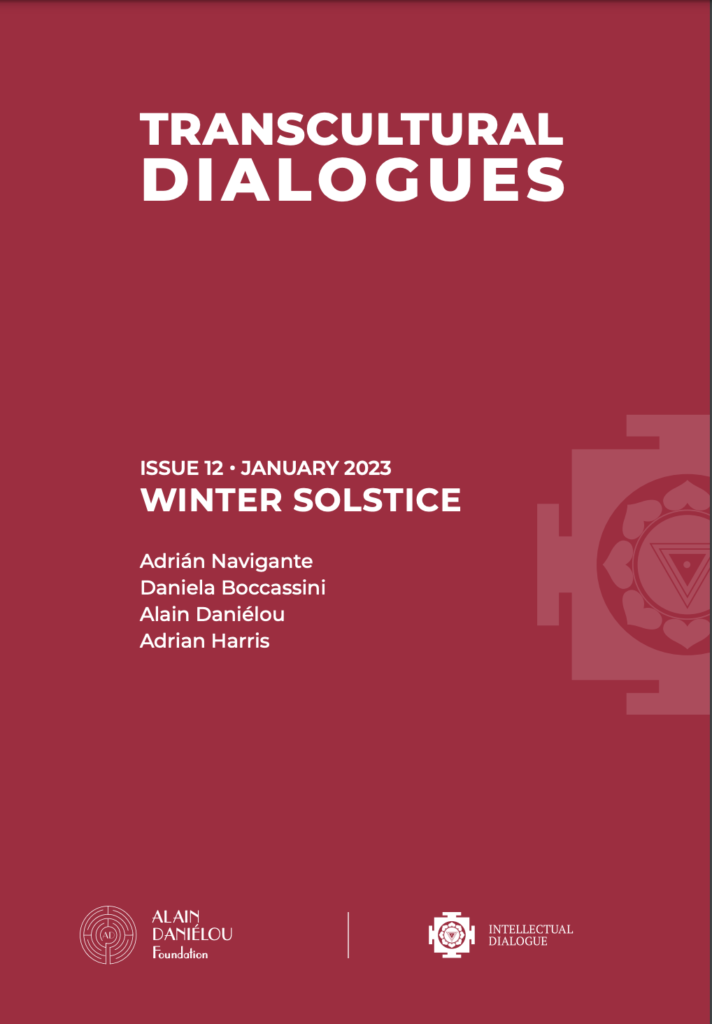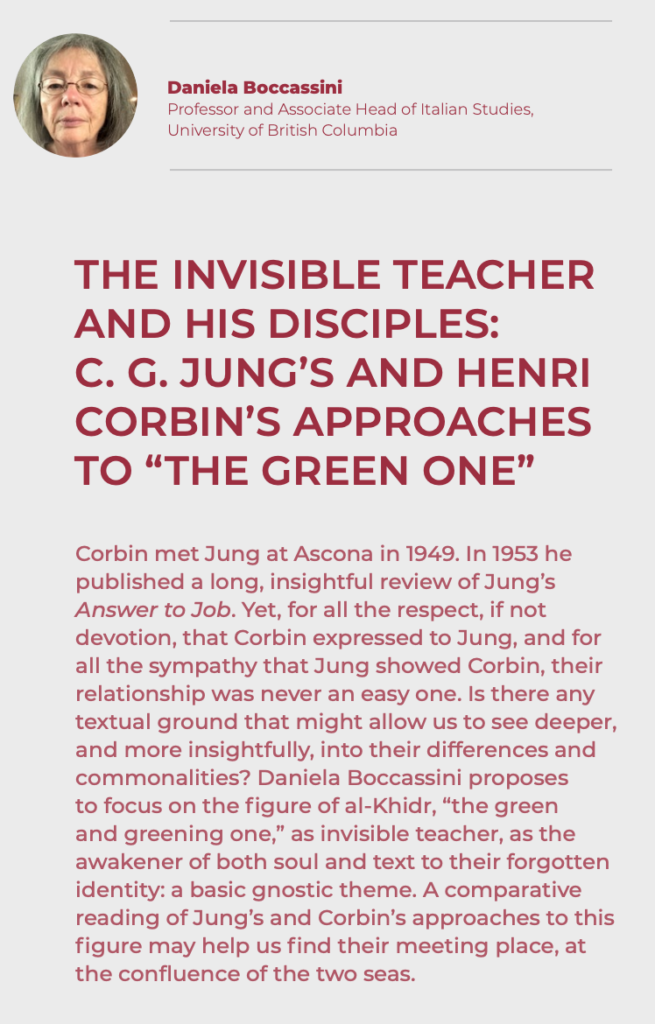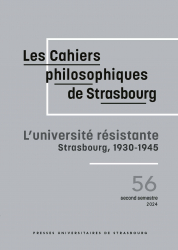Prix international Henry Corbin 2023
11 diciembre 2022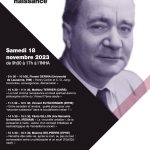
Journée Henry Corbin 2023
9 octubre 2023The Invisible Teacher and His Disciples: C.G. Jung’s and Henry Corbin’s Approaches To “The Green One”
Daniela Boccassini
THE INVISIBLE TEACHER AND HIS DISCIPLES: C. G. JUNG’S AND HENRY CORBIN’S APPROACHES TO “THE GREEN ONE”
Corbin met Jung at Ascona in 1949. In 1953 he published a long, insightful review of Jung’s Answer to Job. Yet, for all the respect, if not devotion, that Corbin expressed to Jung, and for all the sympathy that Jung showed Corbin, their relationship was never an easy one. Is there any textual ground that might allow us to see deeper, and more insightfully, into their differences and commonalities? Daniela Boccassini proposes to focus on the figure of al-Khidr, “the green and greening one,” as invisible teacher, as the awakener of both soul and text to their forgotten identity: a basic gnostic theme. A comparative reading of Jung’s and Corbin’s approaches to this figure may help us find their meeting place, at the confluence of the two seas.
Introductory remark
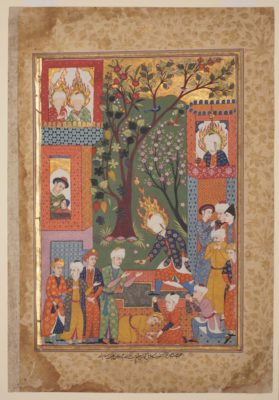
Khidr giving cups of the water of immortality to the inhabitants of Paradise. Falnamah (Book of Divination), ca. 1610-30. Nasser D. Khalili Collection of Islamic Art, MSS 979 Folio 2b. (Public domain)
In attempting to reconstruct, and reassess, Corbin’s and Jung’s relationship to the figure, or the archetype, of the invisible teacher, I will begin by recalling Corbin’s approach to the Avicennian initiatory tale, a narrative intended to foster introversion as self-recognition, on the basis of Corbin’s hermeneutics of ta’will.
I will then proceed to outline the stages of the journey that unfolds, once the encounter with the “invisible teacher” has taken place. After touching on the circumstances of Jung’s and Corbin’s first meeting at Eranos and its relevance to the theme at hand, I will equally briefly trace Jung’s own “night-sea journey” (or tale of initiation) through his encounter with his own “invisible teacher.”
Finally, in essaying to gauge Corbin’s and Jung’s legacies for our time, I will sketch what I see as a possible direction where the archetype of the “invisible teacher” and its avatars, Sophia first and foremost, may be prompting us to move today.
Corbin and the cosmic dramaturgy of the soul
In the early 1950s the commemorations of Avicenna’s millennial prompted Corbin to present, translate and analyse three minor texts by Ibn Sina, which Corbin deemed of the greatest importance however. According to him, what these short recitals, or tales of initiation, revealed to the reader was the humble human adventure underpinning Avicenna’s exalted philosophical and scientific oeuvre. And this was what truly mattered in Corbin’s eyes: because, a thousand years later the philosopher’s grand written achievements “would be in danger of no longer being but paper covered with ink”1 if severed from the author’s secret “mode of presence”, and this irrespective of how glorious certain inks may look, on some of the pages that hand down Avicenna’s works.
In his introduction, Corbin was more or less covertly urging his readers to the need of awakening (as in “prendre conscience”) to the soul, their own soul, and to the soul’s experience as an event of cosmic import—one where the timeless occurrence of an outer and inner mirroring brings consciousness into contact with the unplumbed depths of a fully human, or perhaps more-than-human (in his parlance, Sophianic), way of relating to the world. If Avicenna’s tales are still worth reading today it is because, rather than piling up abstract and more or less outmoded theories on an impersonal, objectifying knowledge of the world, they show instead the pathway to a transpersonal, interconnected knowing with the world.
Having studied, through the 1930s and ’40s, Suhrawardī’s tales of initiation, Corbin was asking himself how steeped in an “Avicennian” atmosphere Suhrawardī’s tales might have been, “when lo ”, one of Avicenna’s tales turned up on his desk as he was studying at the library in Istanbul, due to a wrong call number. Corbin took this as a call to action2. He approached Avicenna’s short narratives in the same way he had Suhrawardī’s, that is to say through his commitment to phenomenology as an existential choice, and to hermeneutics as its attendant discipline. Let me recall in a few words what this means.
At the time of his solitude in Istanbul during WW II (1939-45), Corbin found himself “alone-with-the-alone, in the company of his invisible shaykh”. At the end of that six-year-long retreat, he realized that a different metaphysics had sprouted within him: “I had become an Ishrāqī”3. Suhrawardī’s scriptural legacy had come alive through meeting him, its modern reader, in the re-enactment of an inner dialogue between teacher and disciple; a dialogue that had to be personally experienced, in order for it to be in the first place, and so to become meaningful. This is the type of approach that propitiates what Corbin considers the foundational Urerfharung: primordial soul-experience. By finding his way into the hidden, individualized aliveness of the text-as-teacher, Corbin had in turn been transformed, so that he had now become reborn as the witness of the aliveness of the text, and of his own partnership with it:
It is by showing up, by an act of presence, that [the reader] allows that which is hidden under the phenomenal appearance to become manifest. This act of presence consists in opening, in hatching the future hidden in the so-called outdated past.4
This is definitely not what an academic typically does, but what would befall us, what would the world come to look like, if we tried to follow that scent, that quest for the energy that is invisibly lodged in the text—an energy that, like a musical score, awaits our performance for its self-realization to produce ensoulment as meaning?
Suhrawardī’s scriptural legacy came alive through meeting Corbin, its modern reader, in the re-enactment of an inner dialogue between teacher and disciple.
Only the sacramental recollection of that energy can (re)generate self-knowledge. This also means that if the text as enunciation, as embodiment in time and space is guarded by the figure of the Prophet-as-Scribe, then someone else, a different power, presides over that scriptural body, guarding its potentiality to come alive through the renewal of its meaning: this is a greening power, a watery principle of transcendence-as-immanence and immanence-as-transcendence. This is Khidr, “the Green One”, epiphanizing as “the tenuous thread” of “the esoteric, the unusual” concealed in the text, and in every form. “I am—he says of himself—he who stands at the confluence of the two seas, the one who plunges into the river of the Where, the one who drinks from the source of the source. I am the guide of the fish in the sea of divinity”5. I shall return to this matter of fish momentarily.
This is where the Angel, the Perfect Nature, dovetails with Khidr, the Invisible Teacher who, in the barzakh of the Land of Yuh, reveals to his disciples the co-arising of opposites as the central mystery of a drama which is repeatedly inscribed in every act of cosmic physiology. Here is where angelomorphosis and individuation stand together, on that same invisible island at the confluence of the two seas.
And this is what Corbin calls “angelic pedagogy,” meaning that the practice of the ta’wil of text and soul in the dimension of imaginatio vera is not something we produce by projecting our ego-centered desires in psychic space. It is rather a practice intended to propitiate the manifestation of an archetype, endowed with its own energy, as it comes to meet us on our way6. There is, in other words, an indissoluble link between our modus intelligendi and our modus essendi7. Hence only by entering in resonance with the text’s hidden energy, with the Khidr of the text, we can become in turn the text’s and Khidr’s humble performers.
Advocating a solitary, autonomous, unmediated relationship to the invisible dimension of interiority (the bātin, the esoteric) as a return pathway to the sacred and the consecrated, Corbin was better placed than most to see how, in the desacralized church that modern society unknowingly is, humanity has deified itself, thereby imposing its totalitarian demands on the rest of the living world. If the time of reckoning was and is inevitable, and fast approaching, Corbin’s goal was to offer his fellow human beings the recollection of what they had forgotten: a different, transformational relationship to their own selfhood and hence, to the world.
Corbin meets Khidr
Corbin references Khidr, the Invisible Teacher, numerous times, but most notably in his commentary to the edition of Suhrawardī’s mystical tales8, in his study of Ibn ’Arabi’s “imagination créatrice”9, and in his commentary to the excerpts from ’Abdol-Karīm Gīlī’s Book of the Perfect Man10. I am drastically simplifying here, but I think it is fair to say that Corbin thought of himself as partaking of that same lineage of “presential” approach to Khidr these authors had practiced. This is perhaps why he never showed any interest in trying to elaborate on the figure of Khidr from a historical, mythological or typological perspective: Massignon had already done that.11 He never showed any interest in an in-depth hermeneutical reading of Sura 18 either: Jung had already done that, as we will see momentarily12.
What mattered to Corbin was that Khidr “reveals himself as the repository of an inspired divine science, superior to the law”13, and within the Islamic tradition that meant identifying Khidr’s closeness to the Imam, so much so that Sura 18 became one of the scriptural foundations of shi’ism. But through and beyond that, what really mattered to Corbin was that Khidr was the “initiator to the mystic Truth which emancipates one from literal religion”14—that is to say, from the incarnationist approach to the letter of any and all dogmas, religious or otherwise. In a presential relationship to Khidr as an ever-living vibration, then, the question to be asked is not “Who was Khidr”, but rather “What does it mean to be Khidr’s disciple? To what act of self-awareness does the fact of recognizing oneself as Khidr’s disciple correspond?”15
To answer this question, Corbin follows closely Suhrawardī’s “Narration of the Purple Angel”16, where the wayfarer does not even meet Khidr, or if he does, he does not (yet) recognize him—a demonstration in itself of Khidr’s skilful psychagogic means. The pleading “I” is only told by “the Wise” that if he really wishes to reach the Spring of Life, he will have to “put on Khidr’s sandals” and enter the Darkness. If he is a true pilgrim, his journey will take him to the Spring of Life, no matter what path he follows. And once he emerges transformed from the waters of that Spring, if he is Khidr, he will attain deliverance, by walking easily through the Mountain of Qaf.
The wayfarer’s quest, in other words, is not a journey to Khidr as an outward manifestation of wisdom. Even the Wise will soon disappear, leaving the wayfarer to his own devices. By being summoned to wear Khidr’s sandals, the novice is rather urged “to attain to the Khidr of [his] being, for it is in this inner depth, in this ‘prophet of your being’ that springs the Water of Life”17. There are two aspects to this inward challenge. The first concerns the individual in relation to the teacher: “To have him as a master and initiand is to be obliged to be what he himself is. Khidr is the master of all those who are masterless, because he shows all those whose master he is how to be what he himself is: … [i.e.] the esoteric truth which … frees us from the literal religion”18. The second aspect concerns Khidr’s univocal relationship to each one of his disciples, and of those disciples among themselves: “Khidr is the master of all these, because he shows each one how to attain the spiritual state which he himself has attained” and at the same time “he exemplifies himself as many times as he has disciples, as his role is to reveal each disciple to himself”19.
Now let us examine the seemingly outward aspects of the journey. Impelled to look for the Spring of Life concealed in the Land of Darkness, the wayfarer asks the Wise what that region of gloom should alert him to, once he attains it. Here is the answer, according to Suhrawardī:
The Darkness of which one becomes aware. For you are in Darkness. But are unaware of it. When the wayfarer who takes this path sees himself as being in Darkness, that’s when he understands that he has been all along in Night, and that never yet Day light has reached his eyes …The seeker of the Spring of Life in Darkness goes through all kinds of bewilderments and afflictions. But if he is worthy of finding that Source, eventually after Darkness he will behold the Light.20
The Source of Life wherein the seeker must immerse himself so as to behold the Light and become Khidr will be found when the symbolic dimension of darkness is achieved within. And that immaterial darkness has two faces: outwardly, it is the darkness of the ego-centered illusion in which all human beings are unknowingly plunged. But if through an act of conscious self-mirroring, one succeeds in seeing oneself projected and lost in that gross dimension of darkness, then access to the inner, moon-lit subtle darkness of darkness is gained: and that is where the Spring of Life awaits the seeker. The journey from one kind of darkness to the other is as long as it is strenuous; it calls for the death of one’s outer, ego-centered consciousness, so that rebirth as Khidr in the Waters of Life may take place.
If Suhrawardī’s psychagogy of the soul sounds very much like an alchemical opus—or like a process of individuation— it is because that’s what it is. We do not know when Corbin started to develop an interest in Jung’s works and read his books, but likely upon his return from Istanbul, at the suggestion of Massignon. Yet one thing is certain. In 1948 Olga Fröbe-Kapteyn had invited him to attend the Eranos conference. By the time Corbin made his acquaintance with Casa Gabriella and its distinguished guests, he had read most of what Jung had published. When they first shook hands, in Ascona, Corbin knew what Jung could not have fathomed: namely, that Jung had before him one of the very few among his readers who could understand what he meant, because he, Corbin, was likely the only one who could see where Jung was coming from, and more importantly, where Jung, or Jung’s daimon, was headed.
Corbin meets Jung
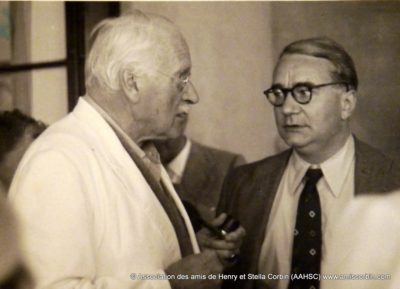
Henry Corbin and C. G. Jung at Eranos, August 1950. © Association des Amis de Stella et Henry Corbin.
At his first Eranos Conference, in August 1949, Corbin lectured on “The initiatory tale and hermeticism in Iran”.21 With this address, he wished to introduce his audience, Jung especially, to Suhrawardī’s two short texts: “L’archange empourpré” (The reddening archangel) and “Le récit de l’exil occidental” (The tale of the occidental exile). He argued that, through and beyond their obvious ties to Sura 18, these tales, of an Avicennian emanationist feel, re-enacted the ancient Hermetic literature of initiation, rich in alchemical, transmutative undertones, with reverberations of the Mazdean theme of the Angel as celestial double. Jung may have known nothing of Suhrawardī’s mystical writings, but he had discussed the alchemical underpinnings of Sura 18 in an impromptu lecture on “rebirth” he had delivered, ten years earlier, from the same Eranos podium from which Corbin was now speaking.22
Building on Jung’s insights, Corbin was now suggesting parallels with the Mithraic and Zoroastrian traditions, and, even more cogently, he was highlighting affinities with two excerpts from the Ghāyat al-Hakīm or Picatrix, an 8th-century authoritative and widespread manual of hermetic theurgy. One of these excerpts tells how Hermes, upon descending into the world of Darkness, meets there his Perfect Nature, and receives instructions on how to achieve liberation through self-awareness23. The other excerpt teases out the figure of the Perfect Nature: Angel or higher Self, this invisible and ever-present being is none other than “the spiritual entity of the philosopher, conjoined to his star, who rules him and opens for him the doors of Wisdom”24.
Corbin’s main concern rested with the Ismaili-hermetic-alchemical “hierogamy of the soul and the Angel”.25 It is this coniunctio of the Masculine and the Feminine, of the light of Day and the shadows of Night that produces rebirth: conscious existence in a state of dualitude wherein the Angel/Perfect Nature/individualized Noūs stands in a relationship to the soul that mirrors the relationship that Hermes entertains with Poimandres, the alchemist with the stone. Even though Khidr was only hinted at, it is clear that Corbin had understood how the Khidr archetype, “the Noūs, the Angel, or the Perfect Nature kindles in the conscious soul a succession of images (or the stages of a mythical journey) wherein the soul (like Hermes who had put his torchlight under a glass) contemplates the archetypal form which was there from the very beginning”26. This process reaches its climax when the soul immerses itself in the waters of the Source of Life, the alchemical aqua permanens, and becomes Khidr: it is reborn and awakens to the Khidr of itself. Thus, Corbin declares, Suhrawardī’s treatise “identifies a crucial synchronism between the transmutation of the Stone and the angelomorphosis or deification of the human being, the reciprocity of the mystery of the Anthropos and of the alchemical mystery”.27 This is why Corbin could state, however cryptically, that “each Angel is Christ in relation to every individual existence”.28 It is Khidr who presides over each and every one of the individualized theophanies of the Sophianic wisdom of Self-knowledge, and this is the only and true rebirth in novam infantiam that each individual can aspire to, by generating it inwardly, through strenuous, life-long dedication and toil.
We will likely never know what Jung thought of Corbin’s passionate advocating for the Angel; we can reckon he feared an excess of mystic enthusiasm, in this young man’s wildly imaginative language. However this may be, it is a fact that Jung never took a special interest in the Islamic world—neither after traveling to Africa, nor after listening to Massignon’s lectures, and not even after meeting Corbin and receiving from him his books on shi’ite gnosis. Even though those books were devoutly autographed, they remained unopened. And yet: it was Jung who urged Corbin to study the Islamic beginnings of the alchemical tradition, and unquestionably Sura 18 left a deep impression upon him. In the 1939 impromptu lecture at Eranos which I have already recalled, Jung had presented Khidr as a symbol of the Self, and Moses’ ordeal at his hands as a process of individuation. But that was just the tip of the iceberg. Let us turn to Jung then, and see how things played out for him.
Jung and the avatars of the Self
Jung’s first mention of Khidr occurs in his 1912 book Psychology of the Unconscious (Wandlungen und Symbole der Libido), where he outlines the archetype of the “pairs of friends”, such as the Dioscuri, Dhulqarneim [Alexander the Great] and Khidr, or Khidr and Moses, Khidr and Elijah, but also St. John the Baptist and Jesus, then Jesus and Peter, for the purpose of highlighting that “the gods, or figures like Khidr …, are our immortal part which continues intangibly to exist < which, though incomprehensible, dwells among us somewhere >”.29 In the revised edition of the book, which appeared in 1952 augmented with many of the insights Jung had gained along the way, Khidr becomes unequivocally tied to the Self, and alchemically substantiated in that respect. “This is our immortality, the link through which man feels inextinguishably one with the continuity of all life”,30 he adds to the 1912 sentence just quoted. In the 1939 impromptu lecture which he never turned into a fully fleshed-out essay, but which he would nonetheless republish in 1950, he stated: “This other being is the other person in ourselves—that larger personality maturing within us”.31
In other words: the birth of the Self is a “psychic fact” whose real nature is typically overlooked by our ego-centred consciousness, in the same way that Moses and his servant, while searching for “the place where the two seas meet”, at first were blind to the signal of the leaping fish. That which ego-centred consciousness disdains (as does Moses, the mind), or downplays (as does Joshua his servant, the body), is thus the most important thing, flickering at the liminal edge of our attention.
All in all, in his 1939/1950 commentary on Sura 18 Jung keeps Khidr at a distance: he is a symbol of the Self, as demonstrated by his connection to the fish and to the alchemists’ prima materia. Everything appears sober and at arm’s length here.
Yet there is another side to Jung’s engagement with Khidr. Even though he never discussed this other side in his writings, he did as much as adumbrate it in his conversations with trusted confidants, and he summarized it in his late so-called autobiography, Memories, Dreams, Reflections. This other side, then, is the hidden one, which complements the outer one in the same way that the almost invisible warp in weaving complements the weft: without it, neither weft nor weaving would come to the loom. And what is more, Jung’s secret human adventure seems to follow, as faithfully as unknowingly, Avicenna’s long papered-over vestiges, such as decades later Corbin had unearthed and retraced them. Whether we choose to approach Jung’s private recital of initiation through a renewed “acte de présence” as Corbin did in the case of Avicenna’s visionary tales—that is our call, the call for our times.
Jung’s descent into the World of Darkness occurred shortly after the publication of Wandlungen and his breakup with Freud—at a time, that is, when Jung, having retreated from the deprived figure of the visible teacher, was left with no choice but to turn within for guidance. This took the form of an experiment in visioning, recorded first, in an impromptu manner, in The Black Books, and then partially transcribed and re-lived through verbal and visual amplifications in The Red Book. None of this was ever published during Jung’s lifetime. But now that both The Black Books and The Red Book are in print, what we witness in reading them first-hand is a drama of death and renewal, that unfolds in an otherworldly dimension, inhabited by a multitude of figures “ris[ing] out of the unconscious”. One of them stands out: “he developed out of the Elijah figure [of the wise old prophet]. I called him Philemon. Philemon was a pagan and brought with him an Egypto-Hellenistic atmosphere with a gnostic coloration”. “Psychologically—Jung comments—Philemon represented superior insight” in the specific sense of “a force that was not myself”; and he adds: “to me he was what the Indians call a guru … whom I had nilly-willy to recognize as my psychagogue”. Years later, a cultivated Indian told him to his surprise that whilst most people have living gurus, “there are always some who have a spirit for teacher”—and evidently that had been Jung’s case.32
Building on C. G. Jung’s insights, Corbin suggested parallels of Islamic mysticism with the Mithraic and Zoroastrian traditions, and, even more cogently, he highlighted affinities with two excerpts from the Ghāyat al-Hakīm or Picatrix, an 8th-century authoritative and widespread manual of hermetic theurgy.
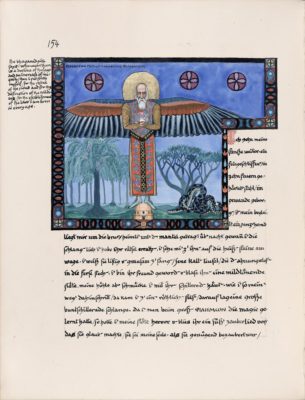
Philemon, Jung’s guide in his visionary experiences. Jung’s Liber novus; Liber secundus, page 154. Reproduced by permission © 2009 Foundation of the Works of C. G. Jung, Zürich. First published by W.W. Norton & Co.
Among the later pages of The Black Books which Jung never managed to transcribe in The Red Book, one is of special relevance to my purpose. It is dated May 20, 1917. On that page, Jung’s “I” asks his soul to ask Philemon: “who he is and what he is to me”. Then he would also like to know who is “Phánēs”, “the luminous one” who was born to him sometime before. What follows is a dialogue between the soul and Philemon, Jung acting as the silent witness, the humble note-taker. Let us hear what Philemon has to say:
This man would like to know who I am. Did I not tell him who I was and who I am? I did not say who I will be. I will be Phánēs. I will dissolve myself in his splendor when this man dies. I do not die, I am already Phánēs, not a man but a flame of God. I am more earthy than earth. I am subterranean, I grew upward, I grew through this man. I overcame him. I am his work, what he has lived. He is not I. He belongs to earth. / Phánēs is the eternal fire, the encompassing blaze, that will become invisible and visible, the eternal dawning. /I am Chider [Khidr], entering youth in old age. When my work is complete, I will have become the seed of the beginning. / This man is my work, which I have built from star seed. Yes, he plunged from the indeterminate and supplied the occasion for form. He formed me, I formed him. He kissed the earth, and I, the sun. … I am the master.33
One would be hard-pressed to find a more explicitly visionary dramaturgy of the partnership that obtains between Khidr and his disciples—both in terms of the “work of darkness” necessary for the human psyche to be able to host the birth of the new god, Phánēs, and in terms of the Gnostic-Hermetic worldview that sustains, literally inspires, the unfolding of this partnership.
In the second part of the dialogue, Philemon-Khidr addresses the soul, who in her blindness fails to see the relationship that binds her to each and all of these figures, even as she is their sole connector. Prompted by Philemon, the soul eventually asks: “What was I? What will become of me?” And he: “You are my daughter from the beginning. We are united in the Pleroma, in the eternal non-existent mother, which is your mother and mine. / You are my mother, my sister, my wife. I produced this man from you, and I will become my son and my son’s son”.34
In this dramaturgy Jung translates into human language—the language of his soul and ours—the articulations of descent into the Region of Darkness as he experienced it. Visionary events such as these are precisely the kind of individualized experiences that we find lacking in the dialogues of the Corpus Hermeticum, of Avicenna and Suhrawardī, and of so many of the medieval alchemical treatises. Here we see how Soul is brought to remember who she is: Philemon-Khidr’s eternal daughter. I will return to the soul’s relationship to Khidr at the end.
Here I must add that in the fall of 1917 another figure emerged, in relation to Philemon: that was Ka, whom Philemon understood as his inseparable shadow, the “son of darkness”.35 Their confrontation on Jung’s pages is gripping. Ka and Philemon-Khidr are inseparable in the same way that the letter and the spirit, the exoteric and the esoteric, the embodied and the volatile are. “Ka was he who made everything real, but who also obscured the halcyon spirit, Meaning, or replaced it with beauty, the “eternal reflection”.36
When Phánēs, the child-god of light, first manifested, Jung made various paintings of him. In one of them, he is represented as a theophany, appearing through darkness. Two towering figures appear at the sides of the central “I” raising his grail, so as to form the columns of the arch within which the scene is inscribed: they are Philemon to the right, and Ka to the left. Philemon holds in his hands the text of the Seven Sermons, Ka that which he loves to build: “a house, a palace, a dwelling or a tomb, a lodging for eternity”37.
And yet, on 14 February 1918, Philemon will brush off all of Ka’s reasons for building temples and altars to Phánēs:
Consider, Ka: he is a new God—something new is truly new, although you grasp it ineptly. It happened as you thought a thousand times, and it happened differently for the thousand and first time. You must build millions of temples, one for each man, to capture this God. … I fear that your temple is dedicated to you.38
Philemons, and Jung’s vision of a new religion where worship only happens in the temple of each individual’s heart, comes very close to Corbin’s own understanding of the religious experience. And Phánēs, as Philemon predicted, declared himself the next epiphany of Philemon-Khidr. It would mark Philemon’s victory over his own shadow. Indeed the rebirth of the human being could now be seen as the Grail of the God.
Considering all this, I do not think it preposterous to say that Jung not only was initiated by Khidr and had become one of his disciples. He also inwardly experienced how Khidr might well be the prophet for the Aeon awaiting humanity, once the time of Ka’s shadow wanes.
Jung too, just like Corbin, remained committed to the more-than-human task of finding the language that would allow Khidr’s message to be heard within the Western world, through and beyond the shadows of secularized religion. Jung’s life-task, his striving to attain to the Khidr of himself, lay in finding a language for individuation that would adapt to the needs of our psychotic rationalism.
Perhaps here we can hear an echo of Ka’s concretizing ambitions, yet if we take into account Jung’s distrust of the world he lived in, we come to see a different picture: “Our myth [Christianity] has become mute, and gives no answer. The fault lies not in it as it is set down in the Scriptures, but solely in us, who have not developed it further, who, rather, have suppressed any such attempts”39. I have no doubt that when Corbin read these lines, in 1962, he recognized in them the signature of one of Khidr’s true disciples.
Al-Khidr’s progeny: yesterday, today, tomorrow
As Corbin noted repeatedly: “The panic aroused by Latin Avicennism among the orthodox believers of the West might perhaps be defined as the fear of having to recognize the individual ministry of Khidr”—and of having to come to terms with the countless ways in which that ministry could manifest, so that each individual may attain “the Khidr of his own being”.40
That individual ministry certainly marked, each in their own way, Corbin in his encounter with ishraqī gnosis, and Jung in his “confrontation with the unconscious”. As disciples of Khidr, both Jung and Corbin were deeply engaged in announcing to their contemporaries that the time of institutionalized monotheisms was coming to an end. Humanity had been called to an altogether different form of religiosity, which as far as they could tell had been present all along as the esoteric, invisible companion of the exoteric institutions. Any truly new way would have to invest the individuals in their relationship to the human, the other-than-human and the more-than-human dimensions of existence. Here, their language reached as far as their inner eyes could see. It is for us to heed what they tried to make out and pointed toward.
So how can all this translate in our time, and how may we consciously contribute to the unfolding of the process, in a Khidr-inspired fashion?
I’d like to turn to Jung once more. Towards the end of his long Red Book enterprise, as he was transcribing his encounter with Philemon-Khidr and the strange ways that his “I” had been led, through apparent nonsense, to see from within his master’s incomprehensible yet deeply transformative teachings, Jung exclaimed: “I venerate your deceptive mantle, you father of all lights and of all ghostlights [aller lichter und irrlichter]”.41 Right after, on the back of that same page, Jung painted a portrait of the “Father of Prophets, Beloved Philemon”.
While carrying on with the transcription of his text, on the facing page Jung painted an even larger image, which bears no obvious relationship to either the text, or the facing portrait of Philemon. A larger-than-life-size feminine figure with veiled face stands in the center of a temple, where, according to Jung’s own later exegesis, she is restored “to the Christian church, not as an icon but as the altar itself”42. Emerging from darkness, she is the light that illumines the scene. A multitude of people dressed in early-20th century clothes crowd beneath and around her, rapturous. Her light garment, her mantle actually, has the color of the moon waxing at her side, and a shower of golden sunlight rains upon her. The Biblical quotes in Gothic script that encircle the scene identify her as Dei sapientia.
Had Corbin been shown this image, he would have exclaimed: “Why! here is the Holy Ghost in feminine form, whom the Medieval Western Avicennians called Madonna Intelligenza, or the Great Mother Sophia”. But what he would have said, upon deciphering the two solitary syllables of Arabic script on the left-hand side of that image? They compose the word “banat”, i.e. “daughters”, in the plural (the singular being “bent”), and point in the direction of Philemon, across the spine of the book. Why daughters in the plural, and whose daughters anyway? Could this feminine figure be understood as Philemon’s progeny, in the process of being unveiled? Could this be a singular representation of Philemon’s many daughters, encompassed within the scriptural tradition of Sophia? I have no definite answers to offer. Yet the Arabic script, which only appears on this page of The Red Book, seem to strengthen the connection between Philemon and Khidr. Following Corbin’s understanding of Khidr as « the Greening One », we might understand Khidr-Philemon as the sapientia Dei, which is now in the process of manifesting in its age-old form, as the anima of each and every one of Khidr’s disciples. Now the esoteric epiphany of unity in the plurality of life may be accomplished, thus rebalancing the exoteric drive toward the suppression of plurality into so-called unanimity, as preached by the « prophets of revelation”.
This would also amount to saying that for a vision of sacredness to be restored to this world, our inner eye ought to turn to the feminine. Indeed, Corbin devoted himself to tracing the relationship between “the Perfect Nature of the mystic and the archetypal Angel of humanity”. A paragraph from Avicenna and the Visionary Recital is worth rereading here:
The epiphanic forms and the names of this Guide can be many; the Guide [Jung would have said “the master”] is always recognizable. It may be … any figure individualizing the relation of the soul to the Active Intelligence. In every case this figure represents the heavenly counterpart of the soul.43
I believe that tracing the connection between the progenitor of the prophets’ “greening power” and the feminine epiphany of the divine, the creative, as an individualizing force, may well be our call, at this time. Sophia’s archetype is at work anyway, and quite possibly in its irate, rather than compassionate form. But in order to see her, we need to train ourselves, and the place to begin is within us, through a ta’wil of the soul as world, and the world as soul.

There is perhaps one example I can offer of this transmutative ability to behold the living world, so that its radical aliveness, its intrinsic “birthing, or germinating, power” may become visible. What I’d like to show you is a case of what Élemire Zolla called “secret truths exposed in plain view”, something like the alchemists’ prima materia. Perhaps not coincidentally, it is a painting that our so-called civilization has, in the digital age, exploited, defaced and vilified like no other, thus turning it into the icon of its own unbridled penchant for prostitution. We think we know what its author intended to do in painting it, but depending on how we look at it, the tables may suddenly turn on us.
So here it is. On a small wooden panel, the peaceful, self-aware image of a female figure rises against the backdrop of an utterly visionary landscape. Is it really the portrait of an “actual” woman in an “actual” outdoor space that we are called to behold? A jewel unto herself, Mona Lisa seems endowed with transcendent omnivoyance: a Christ-like, more-than-human, kind of vision. The more I behold her, the more I become convinced that she is Leonardo’s mirror-image, but not just because of her outward facial features. Mona Lisa is Leonardo’s double in a much subtler way: she is his guardian angel, his celestial twin, his divine anima. She is the feminine manifestation of his fully individuated self, and thereby she is also the imaginal epiphany of the eternal Sophia and, concurrently, of Mother Nature.
At this point into the journey of our species on earth, the anima is She who can propitiate for us, in us, and through us the aliveness of the cosmos; the one, the only one, who can and will teach us to remember who we are, as individuals and as a species—if and when we become willing to take the thread she is offering into our hands and thus walk all the way back to Khidr: to the sacred, labyrinthine heart of all existence.44
At the end of his life, Jung became fond of “a fine old story about a student who came to a rabbi and said, ‘In the olden days there were men who saw the face of God. Why don’t they any more?’ The rabbi replied, ‘Because nowadays no one can stoop so low’.” And he added: “One must stoop a little in order to fetch water from the stream.”45 I believe what he really meant to say was “from the Fountain of Life in the Region of Darkness” where Khidr lives.
Just like Jung, Corbin also took full measure of the lowness, and the loneliness, of that stooping. It is up to us whether we choose to “wear Khidr’s sandals” and stoop, or perhaps more brutally, at this point in time, descend to the dregs of our collective selves. One thing is certain: we need to awaken to the Region of Darkness, whose density, for all of our so-called progress, has never been so eerie, so bloody, and so deep.
Yet both Jung and Corbin knew that “Light is manifest in the darkness, and—as Hölderlin had already said in his visionary hymn “Patmos”—out of danger the rescue comes”.46
- H. Corbin, Avicenna and the Visionary Recital, tr. Willard Trask. Princeton 1990 (1st ed. 1960), p. 5.
- H. Corbin, Avicenna, p. xx.
- Cahier de l’Herne Henry Corbin, dirigé par Christian Jambet. Paris 1981, pp. 45-46.
- Cahier de l’Herne, p. 27.
- H. Corbin, Spiritual Body and Celestial Earth: From Mazdean Iran to Shi’ite Iran, tr. N. Pearson. Princeton 1989, p. 157.
- On ta’wil see Henry Corbin, Avicenna, p. 28-35.
- Cahier de l’Herne, p. 26.
- Sohravardī, L’archange empourpré. Quinze traités et récits mystiques traduits du persan et de l’arabe, présentés et annotés par Henry Corbin. Paris 1976.
- H. Corbin, Alone with the Alone: Creative Imagination in the Sufism of Ibn ’Arabî, tr. R. Mannheim, with a preface by Harold Bloom. Princeton 1997 (1st French ed. 1958; 1st English translation 1969).
- H. Corbin, Spiritual Body and Celestial Earth, pp. 148-59.
- Louis Massignon, “Élie et son role transhistorique, Khadiriya en Islam. In Études carmélitaines 35 (1955), pp. 269-89.
- C. G. Jung, “On Rebirth.” (1940/1950). InN The Archetypes and the Collective Unconscious. CW 9.1. Princeton 1968, pp. 113-50.
- Corbin, Alone with the Alone, p. 55.
- Corbin, Alone with the Alone, p. 57.
- Corbin, Alone with the Alone, p. 59.
- Sohravardī, L’archange empourpré, pp. 193-220.
- Corbin, Alone with the Alone, p. 61.
- Corbin, Alone with the Alone, p. 60.
- Corbin, Alone with the Alone, pp. 60-61.
- Sohravardī, L’archange empourpré, p. 212.
- “Le Récit d’initiation et l’hermétisme en Iran (recherche angélologique)”. Eranos-Jahrbuch, XVII/1949, Zurich 1950, pp. 127-187; republished in L’homme et son ange. Initiation et chevalerie spirituelle, Paris 1983, pp. 7-80.
- Cf. the already mentioned “On Rebirth,” now in CW 9.1.
- Henry Corbin, L’homme et son ange, pp. 52-53.
- Henry Corbin, L’homme et son ange, p. 54.
- Henry Corbin, L’homme et son ange, p. 58.
- Henry Corbin, L’homme et son ange, p. 54.
- Henry Corbin, L’homme et son ange, p. 37.
- Henry Corbin, L’homme et son ange, p. 67.
- C. G. Jung, Symbols of Transformation (1912/1952). CW 5, Princeton 1974, § 296. I am quoting from the first English translation of Wandlungen: Psychology of the Unconscious. A Study of the Transformations and Symbolisms of the Libido, tr. B. Hinkle. New York 1917, p. 227.
- C. G. Jung, Symbols of Transformation, CW 5,§296.
- C. G. Jung, “On Rebirth.” CW 9.1, §235.
- C. G. Jung, Memories, Dreams, Reflections. Recorded and edited by Aniela Jaffé . New York 1989, pp. 182-84.
- C. G. Jung, The Black Books. 1913-32. Notebooks of Transformation, ed. Sonu Shamdasani. Tr. M. Liebscher, J. Peck, and S. Shamdasani. New York 2020. Vols. 6 (Jan 30, 1916 – May 21, 1917), pp. 195-96.
- C. G. Jung, The Black Books, vol. 6, pp. 198-99.
- C. G. Jung, The Black Books, vol. 7, p. 166. The wooden statuette of Ka (Ephaistos/Loki) sculpted by Jung is reproduced in The Art of C. G. Jung. Edited by the Foundation of the Works of C. G. Jung, Ulrich Hoerni, Thomas Fischer, and Bettina Kaufmann. New York 2019 , cat. 49, p. 119.
- C. G. Jung, Memories, Dreams, Reflections, p. 183
- C. G. Jung, The Black Books, vol. 7, p. 174. Jung’s painting is reproduced in The Art of C. G. Jung, 2019, cat. 53, p. 125.
- C. G. Jung, The Black Books, vol. 7, pp. 174-75.
- C. G. Jung, Memories, Dreams, Reflections, p. 332.
- Corbin, Alone with the Alone, p. 62.
- The Red Book. Liber Novus. Edited by S. Shamdasani. Preface by U. Hoerni. Tr. M. Kyburz, J. Peck, and S. Shamdasani. New York 2009, p. 153 of the Second Book, and 317.
- C. G. Jung, The Psychological Aspects of the Kore. CW 9.1 §380.
- Henry Corbin, Avicenna, p. 21.
- I have already commented on Leonardo’s Mona Lisa along these same interpretative lines in “Beyond Narcissism: Mirroring, Mandalas, and Feminine Self-Remembering.” Jung Journal: Culture and Psyche 12 (2018), pp. 26-51.
- C. G. Jung, Memories, Dreams, Reflections, p. 355.
- C. G. Jung, Mysterium Coniunctionis (1955/1970). CW 14, § 258.
